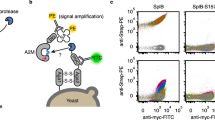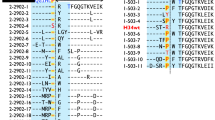Abstract
Mouse granzyme B is the prototypic member of a subfamily of serine proteinases expressed in cytolytic lymphocytes. Molecular modelling of granzyme B indicated that the side chain of Arg 208 partially fills the specificity pocket, thus predicting the preference of this enzyme for substrates containing acidic side chains, a feature unique among eukaryotic serine proteinases. Replacement of Arg 208 with glycine results in an enzyme lacking this activity, but which is able to hydrolyze hydrophobic substrates. These results demonstrate unequivocally that the substrate preference of granzyme B is determined by a positive charge in the specificity pocket and also represent one of the few examples of rational and efficient alteration of serine proteinase substrate-specificity following a single amino acid substitution.
This is a preview of subscription content, access via your institution
Access options
Subscribe to this journal
Receive 12 print issues and online access
$189.00 per year
only $15.75 per issue
Buy this article
- Purchase on Springer Link
- Instant access to full article PDF
Prices may be subject to local taxes which are calculated during checkout
Similar content being viewed by others
References
Lobe, C.G., Finlay, B.B., Paranchych, W., Paetkau, V.H. & Bleackley, R.C. Novel serine proteases encoded by two cytotoxic T lymphocyte-specific genes. Science 232, 858–861 (1986).
Lobe, C.G., Havele, C. & Bleakley, R.C. Cloning of two genes that are specifically expressed in activated cytotoxic T lymphocytes. Proc. natn. Acad. Sci. U.S.A. 83, 1448–1452 (1986).
Brunet, J.-F. et al. The inducible cytotoxicT-lymphocyte-associated gene transcript CTLA-1 sequence and gene localization to mouse chromosome 14. Nature 322, 268–271 (1986).
Masson, D. & Tschopp, J. A family of serine esterases in lytic granules of cytolyticT lymphocytes. Cell 49, 679–685 (1987).
Brunet, J.-F. et al. CTLA-1 and CTLA-3 serine esterase transcripts are detected mostly in cytotoxic T cells, but not only and not always. J. Immunol. 138, 4102–4105 (1987).
Shi, L., Kraut, R.P., Aebersold, R. & Greenberg, A.H. A natural killer cell granule protein that induces DNA fragmentation and apoptosis. J. exp. Med. 175, 553–566 (1992).
Rawlings, N.D. & Barrett, A.J. Evolutionary families of peptidases Biochem. J. 290, 205–218 (1993).
Schector, I. and Berger, A. On the size of the active site in proteases. I. Papain. Biochem. biophys. Res. Comm. 27, 157–162 (1967).
Murphy, M.E.P. et al. Comparative molecular model building of two serine proteinases from cytotoxic T lymphocytes. Proteins Struct. Funct. Genet. 4, 190–204 (1988).
Odake, S. et al. Human and murine cytotoxic T lymphocyte serine proteases: Subsite mapping with peptide thioester substrates and inhibition of enzyme activity and cytolysis by isocoumarins. Biochemistry 30, 2217–2227 (1991).
Poe, M. et al. Human cytotoxic lymphocyte granzyme B. Its purification from granules and the characterization of substrate and inhibitor specificity. J. biol. Chem. 266, 98–103 (1991).
Kakudo, S. et al. Purification, characterization, cloning and expression of glutamic acid-specific protease from Bacillus licheniformis ATCC 14580. J. biol. Chem. 267, 23782–23788 (1992).
Howard, A.D. et al. IL-1 converting enzyme requires aspartic acid residues for processing of the IL-1β precursor at two distinct sites and does not cleave 31-kDa IL-1α. J. Immunol. 147, 2964–2969 (1991).
Jenne, D.E. et al. Isolation and complete structure of the lymphocyte serine protease granzyme G, a novel member of the granzyme multigene family in murine cytolytic T lymphocytes. Evolutionary origin of lymphocyte proteases. Biochemistry 28, 7955–7961 (1989).
Yoshida, N., Everitt, M.T., Neurath, H., Woodbury, R.G. & Powers, J.C. Substrate specificity of two chymotrypsin-like proteases from rat mast cells. Studies with peptide 4-nitroanilides and comparison with cathepsin G. Biochemistry 19, 5799–5804 (1980).
Nakajima, K., Powers, J.C., Ashe, B.M. & Zimmerman, M. Mapping the extended substrate binding site of cathepsin G and human leukocyte elastase. Studies with peptide substrates related to the α1-protease inhibitor reactive site. J. biol. Chem. 254, 4027–4032 (1979).
Caputo, A., Garner, R.S., Winkler, U., Hudig, D. & Bleackley, R.C. Activation of recombinant murine cytotoxic cell proteinase-1 requires deletion of an amino-terminal dipeptide. J. biol. Chem. 268, 17672–17675 (1993).
Delmar, E.G., Largman, C., Brodrick, J.W., Geokas, M.C. A sensitive new substrate for chymotrypsin. Anal. Biochem. 99, 316–320 (1979).
Hedstrom, L., Svilagyi, L. and Rutter, W.J. Converting trypsin to chymotrypsin: the role of surface loops. Science 255, 1249–1253 (1992).
Graf, L. et al. Electrostatic complementarity within the substrate-binding pocket of trypsin. Proc. natn. Acad. Sci. U.S.A. 85, 4961–4965 (1988).
Henriksen, R.A. & Mann, K.G. Substitution of valine for glycine-558 in the congenital dysthrombin thrombin quick II alters primary substrate specificity. Biochemistry 28, 2078–2082 (1989).
Craik, C.S. et al. Redesigning trypsin: alteration of substrate specificity. Science 228, 291–297 (1985).
Perona, J.J., Tsu, C.A., McGrath, M.E., Craik, C.S. & Fletterick, R.J. Relocating a negative charge in the binding pocket of trypsin. J. molec. Biol. 230, 934–949 (1993).
Kornberg, A. Meth. Enzymol. 182, 1–5 (1990).
Nakamaye, K.L., & Eckstein, F. Inhibition or restriction endonuclease Nci I cleavage by phosphorothioate groups and its application to oligonudeotide-directed mutagenesis. Nucl. Acids Res. 14, 9679–9698 (1986).
Bollag, D.M. & Edelstein, S.J. in Protein Methods (Wiley-Liss, New York, 1991).
Redmond, M.J. et al. A serine protease (CCP1) is sequestered in the cytoplasmic granules of cytotoxic T lymphocytes. J. Immunol. 139, 3184–3188 (1987).
Author information
Authors and Affiliations
Rights and permissions
About this article
Cite this article
Caputo, A., James, M., Powers, J. et al. Conversion of the substrate specificity of mouse proteinase granzyme B. Nat Struct Mol Biol 1, 364–367 (1994). https://doi.org/10.1038/nsb0694-364
Received:
Accepted:
Issue Date:
DOI: https://doi.org/10.1038/nsb0694-364
This article is cited by
-
Identification and annotation of bovine granzyme genes reveals a novel granzyme encoded within the trypsin-like locus
Immunogenetics (2018)
-
Homology modelling: a review about the method on hand of the diabetic antigen GAD 65 structure prediction
Wiener Medizinische Wochenschrift (2009)
-
Expression profile of novel members of the rat mast cell protease (rMCP)-2 and (rMCP)-8 families, and functional analyses of mouse mast cell protease (mMCP)-8
Immunogenetics (2007)
-
Targeted induction of apoptosis by chimeric granzyme B fusion proteins carrying antibody and growth factor domains for cell recognition
Cell Death & Differentiation (2006)
-
Expansion of the mast cell chymase locus over the past 200 million years of mammalian evolution
Immunogenetics (2006)



